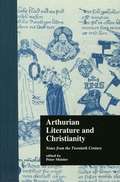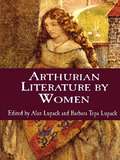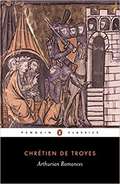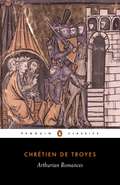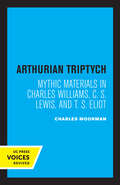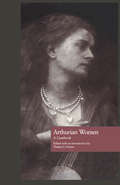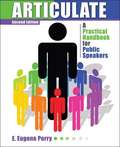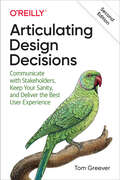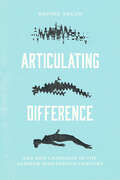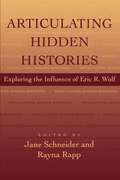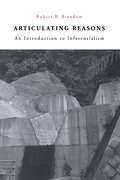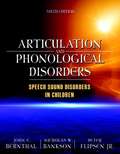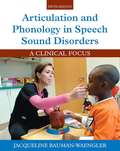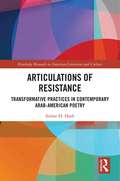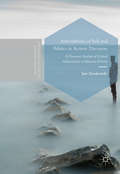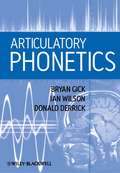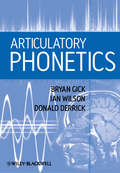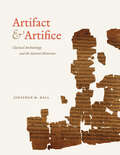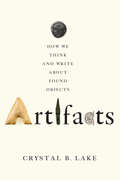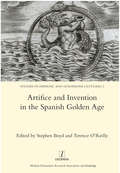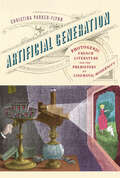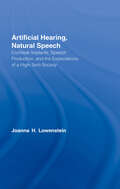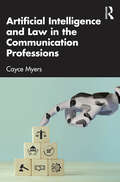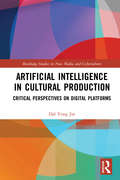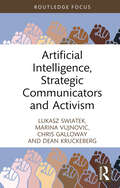- Table View
- List View
Arthurian Literature and Christianity: Notes from the Twentieth Century (Garland Library of Medieval Literature #Vol. 2134)
by Peter MeisterIntended as "the other bookend" to Jessie Weston's work some eighty years earlier, this essay collection provides a careful overview of recent scholarship on possible overlap between Arthurian literature and Christianity. From Ritual to romance and Notes, taken together, bracket contemporary inquiry into the relationship (if any) between Jesus and Arthur. T.S. Eliot's "The Waste Land" is here regarded as one strand joining this matter to many a recent literary riddle (such as the meaning of the term "postmodernism"). Without reprinting work readily available elsewhere and no longer subject to revision through dialogue with fellow contributors, Notes attempts to do justice to all sides in twentieth century exploration of christianity's contribution to an art form which is also grounded in early European polytheism ("paganism").
Arthurian Literature by Women: An Anthology
by Alan Lupack Barbara T. LupackArthurian Literature by Women: An Anthology is a collection of Arthurian poems, stories, and plays by women, from Marie de France to the present, all of which are either significant examples of Arthurian literature or innovative interpretations of Arthurian tradition. Rather than reproducing brief selections from contemporary novels that are readily available, the volume collects and reprints works that have generally been overlooked by students of the Arthurian legend. The volume will be especially interesting to those studying or teaching Women and the Arthurian Legend or any other aspect of myth, fantasy, popular literature, or women's studies.
Arthurian Romances
by Chrétien De Troyes William W. Kibler Carleton W. Carroll<p>Although he didn't invent the Round Table or the tales of its fellowship, the twelfth-century poet Chrétien de Troyes was the first to recount in verse the adventures of Arthur's knights. He is also chiefly responsible for establishing the importance of the Arthurian legend in European literature and assuring its survival into modern times. This sensitive translation of Chrétien's verse narratives features four romances, including those of Erec and Enide, Cligés, Yvain, and Lancelot. <p>Erec and Enide's tale illustrates how honor can be restored to a troubled relationship through acts of public duty. Cligés' tale involves a forbidden relationship, in which a knight falls in love with his queen—who is also his uncle's wife. The story of Yvain explores the effects of long-term absence on a questing knight's marriage. Lancelot's adventure, the rescue of Guinevere, is Chrétien's enduring contribution to the tradition of Arthurian myth. The version included is a principal source of Mallory's popular Le Morte d'Arthur. Lively and accessible, these four romances form the most complete expression of the ideals of French chivalry by a single author.</p>
Arthurian Romances
by Chrétien de TroyesTaking the legends surrounding King Arthur and weaving in new psychological elements of personal desire and courtly manner, Chrétien de Troyes fashioned a new form of medieval Romance. The Knight of the Cart is the first telling of the adulterous relationship between Lancelot and Arthur's Queen Guinevere, and in The Knight with the Lion Yvain neglects his bride in his quest for greater glory. Erec and Enide explores a knight's conflict between love and honour, Cligés exalts the possibility of pure love outside marriage, while the haunting The Story of the Grail chronicles the legendary quest. Rich in symbolism, these evocative tales combine closely observed detail with fantastic adventure to create a compelling world that profoundly influenced Malory, and are the basis of the Arthurian legends we know today.
Arthurian Triptych: Mythic Materials in Charles Williams, C. S. Lewis, and T. S. Eliot
by Charles MoormanThis title is part of UC Press's Voices Revived program, which commemorates University of California Press’s mission to seek out and cultivate the brightest minds and give them voice, reach, and impact. Drawing on a backlist dating to 1893, Voices Revived makes high-quality, peer-reviewed scholarship accessible once again using print-on-demand technology. This title was originally published in 1960.
Arthurian Women: A Casebook (Arthurian Characters and Themes #Vol. 03)
by Norris J. Lacy Thelma S. FensterFeaturing three original and 14 classic essays, this volume examines literary representations of women in Arthuriana and how women artists have viewed them. The essays discuss the female characters in Arthurian legend, medieval and modern readers of the legend, modern critics and the modern women writers who have recast the Arthurian inheritance, and finally women visual artists who have used the material of the Arthurian story. All the essays concentrate interpretation on a female creator and the work. This collection contains a useful bibliography of material devoted to female characters in Arthurian literature.
Articulate! A Handbook for Public Speakers (2nd Edition)
by E. Eugene PerryArticulate focuses on practical applications on public speaking. It enables students to improve their skills through assignments.
Articulating Design Decisions: Communicate With Stakeholders, Keep Your Sanity, And Deliver The Best User Experience
by Tom GreeverTalking to people about your designs might seem like a basic skill, but it can be difficult to do well. In many cases, how you communicate with stakeholders, clients, and other nondesigners may be more important than the designs themselves. Because if you canâ??t get their support, your work will never see the light of dayâ??no matter how good it is.This practical guide focuses on principles, tactics, and actionable methods for presenting your designs. Whether you design apps, websites, or products, youâ??ll learn how to get support from people who have influence over the project with the goal of creating the best user experience.Walk through the process of preparing and presenting your designsUnderstand stakeholder perspectives and learn how to empathize with themCultivate both implicit and explicit listening skillsLearn tactics and strategies for expressing the most effective response to feedbackCreate the right documentation for your decisions to avoid repeated conversationsLearn why following through is just as important as the meeting itself
Articulating Difference: Sex and Language in the German Nineteenth Century
by Sophie SalvoEnriches contemporary debates about gender and language by probing the histories of the philosophy and sciences of language. Drawing on a wide range of texts, from understudied ethnographic and scientific works to canonical literature and philosophy, Sophie Salvo uncovers the prehistory of the inextricability of gender and language. Taking German discourses on language as her focus, she argues that we are not the inventors but, rather, the inheritors and adapters of the notion that gender and language are interrelated. Particularly during the long nineteenth century, ideas about sexual differences shaped how language was understood, classified, and analyzed. As Salvo explains, philosophers asserted the patriarchal origins of language, linguists investigated “women’s languages” and grammatical gender, and literary Modernists imagined “feminine” sign systems, and in doing so they not only deemed sex-based divisions to be necessary categories of language but also produced a plethora of gendered tropes and fictions, which they used both to support their claims and delimit their disciplines. Articulating Difference charts new territory, revealing how gendered conceptions of language make possible the misogynistic logic of exclusion that underlies arguments claiming, for example, that women cannot be great orators or writers. While Salvo focuses on how male scholars aligned language study with masculinity, she also uncovers how women responded, highlighting the contributions of understudied nineteenth-century works on language that women wrote even as they were excluded from academic opportunities.
Articulating Hidden Histories: Exploring the Influence of Eric R. Wolf
by Jane Schneider Rayna RappWith his groundbreaking Europe and the People Without History, Eric R. Wolf powerfully advanced the project of integrating the disciplines of anthropology and history. In Articulating Hidden Histories, many of those influenced by Wolf—both anthropologists and historians—acknowledge the contribution of this great scholar while extending his work by presenting their own original field and archival research.The "hidden histories" referred to here encompass the histories of economic and political forces capable of dislodging people from their surroundings, of the people thus dislocated, and of the anthropological concepts developed to understand such processes. Within this framework, the contributors explore an extraordinarily wide range of topics, from the invention of tribalism in colonial West Africa to the ecological activism of North American housewives.This collection offers a fitting tribute not only to Eric Wolf's work, but to its continuing influence on the fields of anthropology and history.
Articulating Reasons: An Introduction to Inferentialism
by Robert B. BrandomRobert B. Brandom is one of the most original philosophers of our day, whose book Making It Explicit covered and extended a vast range of topics in metaphysics, epistemology, and philosophy of language--the very core of analytic philosophy. This new work provides an approachable introduction to the complex system that Making It Explicit mapped out. A tour of the earlier book's large ideas and relevant details, Articulating Reasons offers an easy entry into two of the main themes of Brandom's work: the idea that the semantic content of a sentence is determined by the norms governing inferences to and from it, and the idea that the distinctive function of logical vocabulary is to let us make our tacit inferential commitments explicit. Brandom's work, making the move from representationalism to inferentialism, constitutes a near-Copernican shift in the philosophy of language--and the most important single development in the field in recent decades. Articulating Reasons puts this accomplishment within reach of nonphilosophers who want to understand the state of the foundations of semantics.
Articulation and Phonological Disorders
by John E. Bernthal Nicholas W. Bankson Peter FlipsenThis is the leading text for courses in clinical phonology-thoroughly revised and updated to include the most current and up-to-date information in the field. Even the newly added subtitle,Speech Sound Disorders in Children, reflects recent changes in the field, including new terminology. This classic text does not prescribe a single approach to phonological disorders but rather presents an eclectic perspective on the nature, assessment, and treatment of this communication impairment. The addition of a third author, Peter Flipsen Jr. , a highly-recognized scholar in the area of clinical phonology, brings important, new information for readers and fresh perspectives to the text. Among the many highlights and special features of the sixth edition are: An entire section devoted to the classification of speech sound disorders; The latest information on Childhood Apraxia of Speech, including a detailed discussion of the 2007 ASHA position statement; A revised and updated comprehensive chapter on Normal Development; A full section on measuring clinical change set within the context of evidence-based practice; An outstanding summary of phonological acquisition information written by leading researcher in this area, Sharynne McLeod; Comprehensive coverage of dialects and phonologic characteristics of speakers with first languages other than English, prepared by leading authorities in this area, Brian Goldstein and Aquiles Iglesias; A completely updated chapter on phonological awareness, co-authored by Laura Justice, Gail Gillon, and C. Melanie Schue. A fully comprehensive and current review of etiological variables, thorough discussion of the assessment of phonologic disorders, and an updated review of broad-based intervention methodologies; and every chapter features introductions, summaries, charts, and graphs to guide learning and aid students' comprehension. The sixth edition of Articulation and Phonological Disorders: Speech Sound Disorders in Children proves once again its "classic" status, and its rightful place on every speech, language, and hearing clinician's bookshelf.
Articulation and Phonology In Speech Sound Disorders: A Clinical Focus
by Jacqueline Bauman-WaenglerThis comprehensive book ties strong academic foundations directly to their clinical application for speech/language therapists working with speech sound disorders. Each chapter presents tools to help readers bridge the gap between theoretical issues and clinical applications by presenting Clinical Applications, Clinical Exercises, Case Studies, and a section called Think Critically, which asks students to further apply specific clinical concepts. Test Yourself multiple choice questions appear at the end of each chapter and are ideal for review and assessment of the knowledge presented in the chapters, and Further Readings allow readers to continue to expand their knowledge. The new Fifth Edition of Articulation and Phonology in Speech Sound Disorders reflects the current use of the term "speech sound disorder," an umbrella term for what was previously noted as articulation- and phonemic-based disorders.
Articulations of Resistance: Transformative Practices in Contemporary Arab-American Poetry (Routledge Research in American Literature and Culture)
by Sirene HarbUsing a theoretical framework located at the intersection of US ethnic studies, transnational studies, and postcolonial studies, Articulations of Resistance: Transformative Practices in Arab-American Poetry maps an interdisciplinary model of critical inquiry to demonstrate the intimate link and multilayered connections between poetry and resistance. In this study of contemporary Arab-American poetry, Sirène Harb analyzes how resistance, defined as the force challenging the dominant, intervenes in ways of rethinking the local and the global vis-à-vis traditional paradigms of time, space, language and value.
Articulations of Self and Politics in Activist Discourse: A Discourse Analysis of Critical Subjectivities in Minority Debates (Postdisciplinary Studies in Discourse)
by Jan ZienkowskiThis book focuses on the discursive processes that allow activists to make sense of themselves and of the modes of politics they engage in. It shows how political and metadiscursive awareness develop in tandem with a reconfiguration of one's sense of self. The author offers an integrated pragmatic and poststructuralist perspective on self and subjectivity. He draws on Essex style discourse theory, early pragmatist philosophy, and linguistic pragmatics, arguing for a notion of discourse as a multi-dimensional practice of articulation. Demonstrating the analytical power of this perspective, he puts his approach to work in an analysis of activist discourse on integration and minority issues in Flanders, Belgium. Subjects articulate a whole range of norms, values, identities and narratives to each other when they engage in political discourse. This book offers a way to analyse the logics that structure political awareness and the associated boundaries for discursive self-interpretation.
Articulatory Phonetics
by Ian Wilson Bryan Gick Donald DerrickArticulatory Phonetics presents a concise and non-technical introduction to the physiological processes involved in producing sounds in human speech. <P><P>Traces the path of the speech production system through to the point where simple vocal sounds are produced, covering the nervous system, and muscles, respiration, and phonation Introduces more complex anatomical concepts of articulatory phonetics and particular sounds of human speech, including brain anatomy and coarticulation <P><P>Explores the most current methodologies, measurement tools, and theories in the field <P>Features chapter-by-chapter exercises and a series of original illustrations which take the mystery out of the anatomy,physiology, and measurement techniques relevant to speech research <P><P>Includes a companion website atwww.wiley.com/go/articulatoryphonetics with additional exercisesfor each chapter and new, easy-to-understand images of the vocal tract and of measurement tools/data for articulatory phonetics teaching and research
Articulatory Phonetics
by Ian Wilson Bryan Gick Donald DerrickArticulatory Phonetics presents a concise and non-technical introduction to the physiological processes involved in producing sounds in human speech. Traces the path of the speech production system through to the point where simple vocal sounds are produced, covering the nervous system, and muscles, respiration, and phonation Introduces more complex anatomical concepts of articulatory phonetics and particular sounds of human speech, including brain anatomy and coarticulation Explores the most current methodologies, measurement tools, and theories in the field Features chapter-by-chapter exercises and a series of original illustrations which take the mystery out of the anatomy, physiology, and measurement techniques relevant to speech research Includes a companion website at www.wiley.com/go/articulatoryphonetics with additional exercises for each chapter and new, easy-to-understand images of the vocal tract and of measurement tools/data for articulatory phonetics teaching and research Password protected instructor’s material includes an answer key for the additional exercises
Artifact & Artifice: Classical Archaeology and the Ancient Historian
by Jonathan M. HallIs it possible to trace the footprints of the historical Sokrates in Athens? Was there really an individual named Romulus, and if so, when did he found Rome? Is the tomb beneath the high altar of St. Peter’s Basilica home to the apostle Peter? To answer these questions, we need both dirt and words—that is, archaeology and history. Bringing the two fields into conversation, Artifact and Artifice offers an exciting excursion into the relationship between ancient history and archaeology and reveals the possibilities and limitations of using archaeological evidence in writing about the past. Jonathan M. Hall employs a series of well-known cases to investigate how historians may ignore or minimize material evidence that contributes to our knowledge of antiquity unless it correlates with information gleaned from texts. Dismantling the myth that archaeological evidence cannot impart information on its own, he illuminates the methodological and political principles at stake in using such evidence and describes how the disciplines of history and classical archaeology may be enlisted to work together. He also provides a brief sketch of how the discipline of classical archaeology evolved and considers its present and future role in historical approaches to antiquity. Written in clear prose and packed with maps, photos, and drawings, Artifact and Artifice will be an essential book for undergraduates in the humanities.
Artifacts: How We Think and Write about Found Objects
by Crystal B. LakeA literary history of the old, broken, rusty, dusty, and moldy stuff that people dug up in England during the long eighteenth century.In the eighteenth century, antiquaries—wary of the biases of philosophers, scientists, politicians, and historians—used old objects to establish what they claimed was a true account of history. But just what could these small, fragmentary, frequently unidentifiable things, whose origins were unknown and whose worth or meaning was not self-evident, tell people about the past?In Artifacts, Crystal B. Lake unearths the four kinds of old objects that were most frequently found and cataloged in Enlightenment-era England: coins, manuscripts, weapons, and grave goods. Following these prized objects as they made their way into popular culture, Lake develops new interpretations of works by Joseph Addison, John Dryden, Horace Walpole, Jonathan Swift, Tobias Smollett, Lord Byron, and Percy Bysshe Shelley, among others. Rereading these authors with the artifact in mind uncovers previously unrecognized allusions that unravel works we thought we knew well. In this new history of antiquarianism and, by extension, historiography, Lake reveals that artifacts rarely acted as agents of fact, as those who studied them would have claimed. Instead, she explains, artifacts are objects unlike any other. Fragmented and from another time or place, artifacts invite us to fill in their shapes and complete their histories with our imaginations. Composed of body as well as spirit and located in the present as well as the past, artifacts inspire speculative reconstructions that frequently contradict one another. Lake's history and theory of the artifact will be of particular importance to scholars of material culture and forms. This fascinating book provides curious readers with new ways of evaluating the relationships that exist between texts and objects.
Artifice and Invention in the Spanish Golden Age
by Stephen BoydThe corpus of literary works shaped by the Renaissance and the Baroque that appeared in Spain during the sixteenth and seventeenth centuries had a transforming effect on writing throughout Europe and left a rich legacy that scholars continue to explore. For four decades after the Spanish Civil War the study of this literature flourished in Great Britain and Ireland, where many of the leading scholars in the field were based. Though this particular 'Golden Age' was followed by a decline for many years, there have recently been signs of a significant revival. The present book seeks to showcase the latest research of established and younger colleagues from Great Britain and Ireland on the Spanish Golden Age. It falls into four sections, in each of which works by particular authors are examined in detail: prose (Miguel de Cervantes, Francisco de Quevedo, Baltasar Gracian), poetry (The Count of Salinas, Luis de Gongora, Pedro Soto de Rojas), drama (Cervantes, Calderon, Lope de Vega), and colonial writing (Bernardo Balbuena, Hernando Dominguez Camargo, Alonso de Ercilla). There are essays also on more general themes (the motif of poetry as manna; rehearsals on the Golden Age stage; proposals put to viceroys on governing Spanish Naples). The essays, taken together, offer a representative sample of current scholarship in England, Scotland, and Ireland.
Artificial Generation: Photogenic French Literature and the Prehistory of Cinematic Modernity
by Christina Parker-FlynnArtificial Generation: Photogenic French Literature and the Prehistory of Cinematic Modernity investigates the intersection of film theory and nineteenth-century literature, arguing that the depth of amalgamation that occurred within literary representation during this era aims to replicate an illusion of life and its sensations, in ways directly related to broader transitions into our modern cinematic age. A key part of this evolution in representation relies on the continual re-emergence of the artificial woman as longstanding expression of masculine artistic subjectivity, which, by the later nineteenth century, becomes a photographic and filmic drive. Moving through the beginning of film history, from Georges Méliès and other “silent” filmmakers in the 1890s, into more contemporary movies, including Alfred Hitchcock’s Vertigo (1958) and Blade Runner 2049 (2017), the book analyzes how films are often structured around the prior century’s mythic and literary principles, which now serve as foundation for film as medium—a phantom form for life’s re-presentation. Artificial Generation provides a crucial reassessment of the longstanding, mutual exchange between cinematic and literary reproduction, offering an innovative perspective on the proto-cinematic imperative of simulation within nineteenth-century literary symbolism.
Artificial Hearing, Natural Speech: Cochlear Implants, Speech Production, and the Expectations of a High-Tech Society (Outstanding Dissertations in Linguistics)
by Joanna Hart LowensteinThis book explores the interface between speech perception and production through a longitudinal acoustic analysis of the speech of postlingually deaf adults with cochlear implants (electrode and computer prostheses for the inner ear in cases of nerve deafness). The methodology is based on the work of Joseph Perkell at MIT, replicating and extending analysis to subjects with modern digital cochlear implants and processor technology. Lowenstein also examines how cochlear implants are portrayed in dramatic and documentary television programs, the scientific accuracy of those portrayals, and what expectations might be taken away by viewers, particularly given modern society's view that technology can overcome the frailties of the human body.
Artificial Intelligence and Law in the Communication Professions
by Cayce MyersThis book analyzes the current attempts to regulate artificial intelligence (AI) and its impact on the communication field.Examining existing and proposed laws, policies, and regulations of AI in the U.S. and the European Union, this book analyzes how the technological development of AI will be governed in the next decade and how this will impact the communication industry. Chapters explore the influence of laws on key communication issues including free speech, disinformation, intellectual property, privacy, and discrimination, as well as the AI industry’s approach to self-regulation. It shows how communication professionals such as public relations practitioners, advertisers, and journalists will be affected by generative AI content production and how communication will ultimately be shaped by the regulations and laws placed on AI.Providing readers with a working knowledge of the contemporary legal issues surrounding AI and communication, this book will be of interest to scholars and students in the fields of Media and Communication Law, Public Relations, Advertising, and Journalism.
Artificial Intelligence in Cultural Production: Critical Perspectives on Digital Platforms (Routledge Studies in New Media and Cyberculture)
by Dal Yong JinThis book offers an in-depth academic discourse on the convergence of AI, digital platforms, and popular culture, in order to understand the ways in which the platform and cultural industries have reshaped and developed AI-driven algorithmic cultural production and consumption. At a time of fundamental change for the media and cultural industries, driven by the emergence of big data, algorithms, and AI, the book examines how media ecology and popular culture are evolving to serve the needs of both media and cultural industries and consumers. The analysis documents global governments’ rapid development of AI-relevant policies and identifies key policy issues; examines the ways in which cultural industries firms utilize AI and algorithms to advance the new forms of cultural production and distribution; investigates change in cultural consumption by analyzing the ways in which AI, algorithms, and digital platforms reshape people’s consumption habits; and examines whether governments and corporations have advanced reliable public and corporate policies and ethical codes to secure socio-economic equality. Offering a unique perspective on this timely and vital issue, this book will be of interest to scholars and students in media studies, communication studies, anthropology, globalization studies, sociology, cultural studies, Asian studies, and science and technology studies (STS).
Artificial Intelligence, Strategic Communicators and Activism (Global PR Insights)
by Marina Vujnovic Dean Kruckeberg Lukasz Swiatek Chris GallowayIn a world that is increasingly wary of artificial intelligence (AI), this book explores the pressing need for strategic communicators to move away from being advocates for AI and move towards a more critical activist role that enables them to counter AI-driven threats to communities and relationships. AI is contributing to inequality, misinformation and environmental damage, among other problems. This book argues that strategic communicators are uniquely placed to help counter AI-driven challenges because of their skills in relationship-building and their ability to craft and deliver messages effectively. By discussing the different professional activist approaches that communicators can take in relation to growing AI challenges, the book offers multiple perspectives that will help to build knowledge in diverse settings and develop practice, especially in community and activist strategic communication. Research-based and combining theory with practice, this thought-provoking book will be welcomed by strategic communication scholars and practitioners alike eager to develop a critical approach to the challenges surrounding AI.
